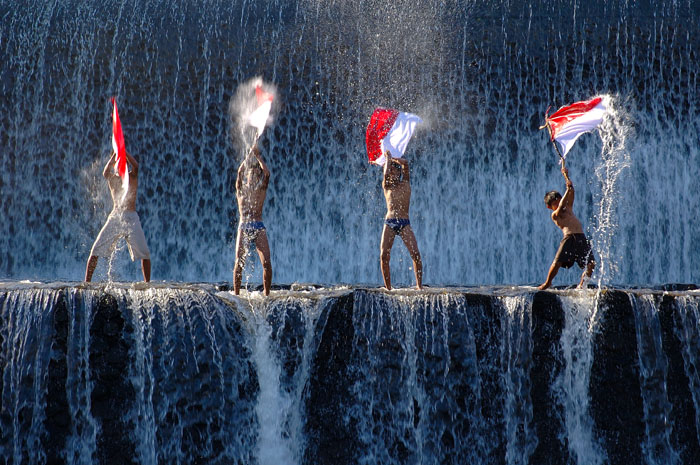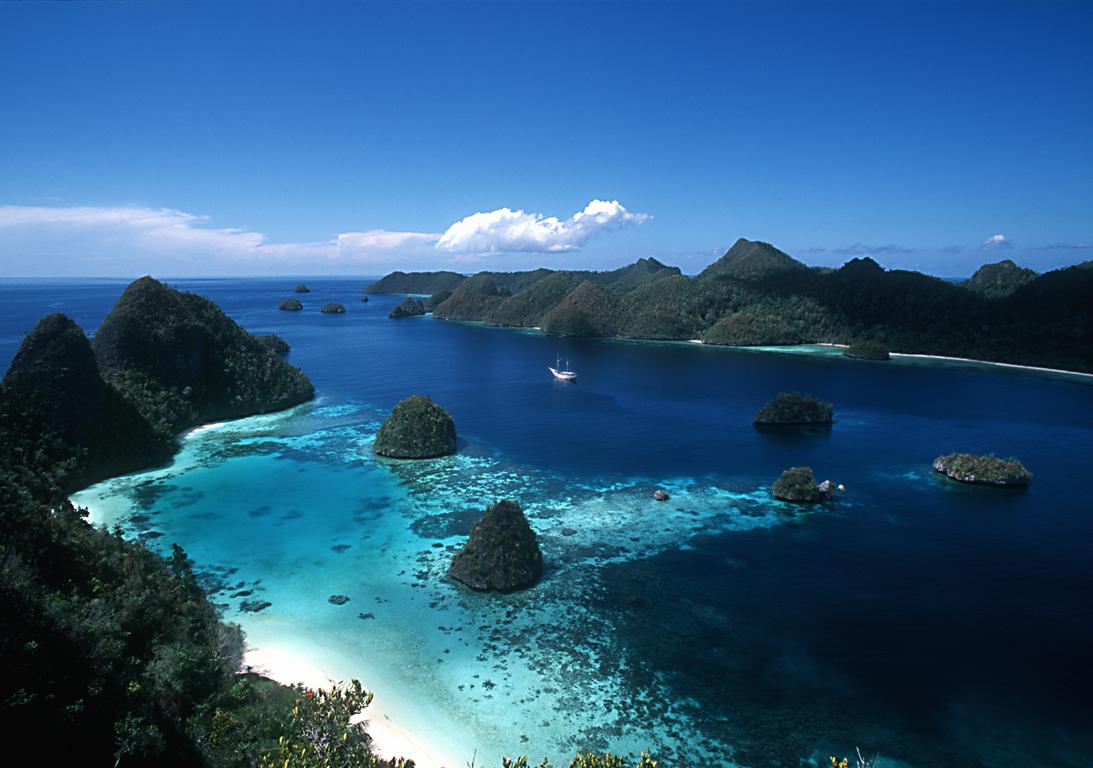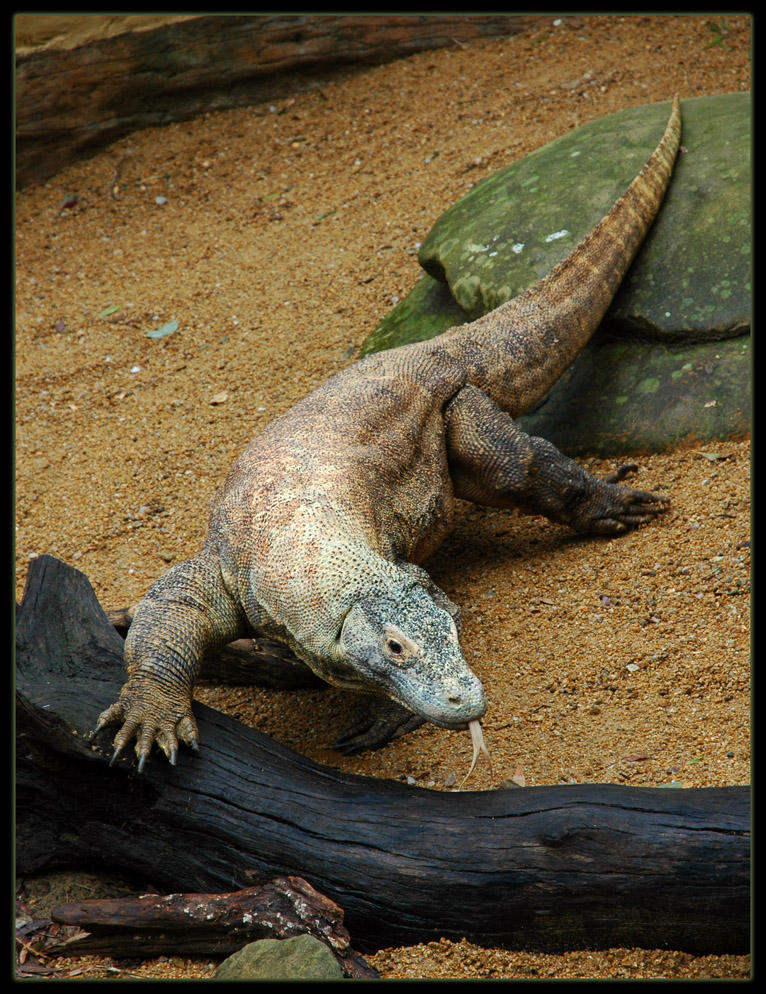The Togian Islands
From April to October, the cruises are located in the
Togian Islands, inside the large Tomini Bay. The Togians include 3 main volcanic islands close together, and another one apart on the North that erupted last in 1984, as well as numerous islets.
It is the only place in the world where barrier reefs, atolls, and fringing reefs are found together. Most of the islands is still covered by dense tropical forest, human settlements and tourism are still very limited.
The Togian islands dives specificity is certainly the beauty and the diversity of the underwater sceneries their offer, with a visibility that is generally very good.
Around the volcanic island of
Una-Una, where we stay for 3 days, sponges size and shape diversity are astonishing, probably among the biggest in the world. The fish life is very dense: schools of jacks and barracudas, Bump head parrotfish's, numerous napoleon wrasses, snappers, fusiliers, etc.
Other dive sites include beautiful drop offs with crevasses and overhangs, canyons, rocks formations, pinnacles, all offering a great variety of spectacular underwater sceneries.
Pelagic life is present on some of the spots with schools of barracudas, tunas, giant trevallies, eagle rays, reef sharks and sometimes hammerhead sharks.
The development and the diversity of coral formations are also a highlight of the Togian islands. The cruise also includes a visit to an
intact plane wreck B24 from the 2nd World War laying on the bottom at eighteen meters depth.
Our twelve days cruise, EXT TOG, covers the 8 days Togian cruise and ends in Luwuk, spending four more days of diving along the eastern tip of the peninsula that separates Tominy bay from Luwuk area. The dive sites of this area -we are the only dive operators there- are mostly rocky formations and pinnacles with an intense marine life and a high density of fishes including pelagic as tunas and giant jacks. Abundant gorgonians, soft corals and daisy corals make also those dives very colorful. For a more precise description of the Peninsula dive sites, please refer to the
Banggai Cruise section.
 Examples of diving sites we visit during the Togian cruise:
Examples of diving sites we visit during the Togian cruise:NB. Most of the dive sites that are walls or slopes can be dive at different depth according to the diver's level and wishes, and if the dive is a morning or an afternoon dive. That's why we sometime mention a depth range rather than a maximum depth.
Dominik rock; Kadidiri Isl., depth 110 feetIt is a rocky formation outside the barrier reef (the barrier reef runs along almost all the north coast of Togian islands). We leave the bottom of the reef wall at a depth of 55 feet and follow the sandy bottom in between massive rocks, where we frequently spot giant groupers. The last rock, at 100 feet depth, makes a wall on its outside part falling in the deep blue, from where are coming up tunas and schools of jacks. We then follow the top of this rock that forms a flat platform covered with colorful soft corals, sponges and splendid huge gorgonians. The dive then go back to the reef wall that we follow, getting slowly up until the lagoon where we finish the dive.
Fishomania; Una-Una Isl., depth 40 - 80 feetUna-Una is a volcanic island in the North of the Togian group. The volcano last eruption was in 1984, and since then human settlements are theoretically forbidden on the islands. In fact, a few inhabitants stay there, taking care of the numerous coconut trees on the lower part of the island, the upper part being covered by dense tropical forest.
Fishomania is a pinnacle with a top a 12 feet deep, where aggregates high densities of fishes: we generally spend a few minutes hanging on some rocks in the current, looking at the non remitting and hypnotic ballet that forms schools of fusiliers, surgeons fishes, snappers, jack fishes and so many others. The outside part of the pinnacle forms a splendid wall covered by dense coral formations of all shapes and colors, associated with sponges of uncommon size and shape.
Turtles and Napoleons are usually spotted, as well as eagle rays and white tips sharks.
Manara 1, Una-Una Isl., 45 to 90 feetOn the Una-Una barrier reef, it is a slope offering a luxuriant hard coral coverage. Another highlight of this dive is a white gorgonian field at 90 feet depth, at the beginning of the dive. Same as on the other sites of Una-Una, you will find a dense fish life all along the dive.
A
pollo reef, Una-Una isl, 90 feetA reef formation on a sandy slope, from 25 to 35 meters depth. As on the other dives on Una-Una, there is always a lot of fishes (schools of surgeons, fusiliers, Napoleon wrasses) but the highlight of the dive is huge schools of barracudas (more than one thousand ?) that comes to check and surround the divers.
Kololio, Una-una isl, 30 feet Night diveWe mention this night dive because in addition to the critters, we generally see turtles, sleeping parrot fishes -including bump head parrot- wrasses, and many other fishes interesting for portraits.
Mimpi Ding-Ding, Pasir Tengah atoll, depth 65 to 100 feetYou dive straight down along an absolutely vertical wall that goes down to abyssal depth (but not you, even though the temptation is hard to resist!). The deep and transparent blue of the water -the visibility is generally excellent- gives to this dive a special fantasy ambient. This the archetype of the "wall", where hang huge tubes and barrel sponges , black corals, where are cruising tunas, eagle rays, ascending and descending schools of Platax and trevallies. The wall also presents beautiful overhangs and crevasses. This a also a typical dive profile of the tropics where you slowly get up along the wall and finish your tanks at the top of the reef looking at the aquarium.
Goa-goa, Pasir tengah atoll, depth 55 feetAnother wall, with a lot of overhangs and horizontal faults. A very good site for photographers, with a good coverage of soft corals. A large swim through at 40 feet deep, with walls and ceiling covered by bright yellow siphonogorgias. The wall between 6 and 3 meters, where we spend the last twenty minutes of the dive, is colonized by an amazing quantity of various nudibranches.
Batu Gila ("Crazy stone"), 100 feetA special spot for pelagics outside the barrier reef of Kadidiri. A reef with a top at -27 mts, on a sandy bottom of about 70 mts. When the currents are strong at certain periods of the tide, the fish life is very dense: Schools of jacks, barracudas, white tips, grey reef sharks and sometime hammerheads. Due to the strong currents , this dive is only offered to experienced divers.
Gunung laut, South Togians, Depth 80 feetComing up from a bottom of more than 200 meters, this pinnacle that culminates at -27 meters is visited by numerous pelagic fishes: tunas, white tips and grey reef sharks, schools of jacks. Beautiful coverage of soft corals.
This area has several pinnacles that are probably all good diving sites, but we practice only two of them. Some room for exploration, mention it on board if you are interested.
B24 liberator, South Togians, depth 60 feetThe wreck, a American B24 bomber from the Second World War, lays almost intact on a 18 meters bottom. The plane was on its way back to its base on Morotai Island (North Mollucas) when an engine went on fire. The pilot managed to alight on the waters of this calm bay. All the crew was safe and went to the land where the local people rescued them.
A large school of jacks is always on the spot; shrimps, glass fishes, crocodile fishes.
For more information : http://www.wallacea-divecruise.com/togians.html






















 All visitors to the Bunaken National Park (divers and non-divers) are required to pay an entrance fee, in accordance with North Sulawesi Provincial Government Provincial Law Number 9/2002. The entrance fee for foreign visitors is Rp 50,000 per daily ticket (approximately US$6), or Rp 150,000 (approximately US$17) for a waterproof plastic entrance tag valid for the full calendar year.
All visitors to the Bunaken National Park (divers and non-divers) are required to pay an entrance fee, in accordance with North Sulawesi Provincial Government Provincial Law Number 9/2002. The entrance fee for foreign visitors is Rp 50,000 per daily ticket (approximately US$6), or Rp 150,000 (approximately US$17) for a waterproof plastic entrance tag valid for the full calendar year. In general diving standards in North Sulawesi are high, as is environmental awareness among the dive operators, at least the ones who have formed the
In general diving standards in North Sulawesi are high, as is environmental awareness among the dive operators, at least the ones who have formed the 


